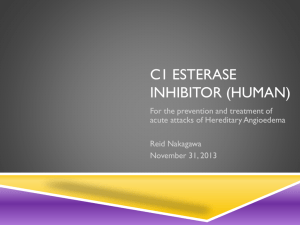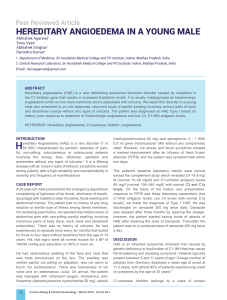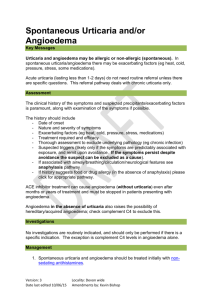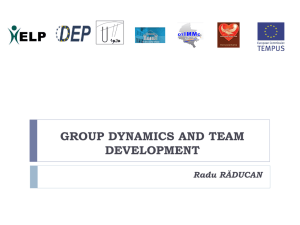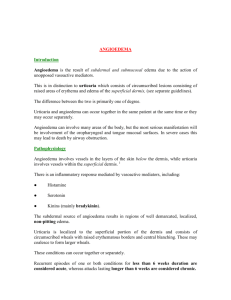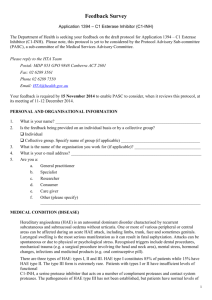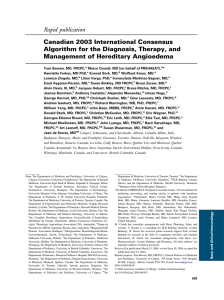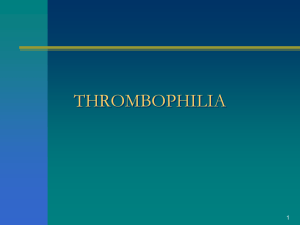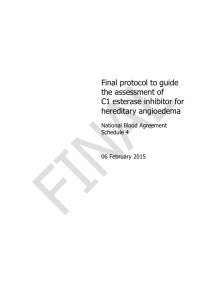Successful Treatment of Acquired Angioedema Using B
advertisement
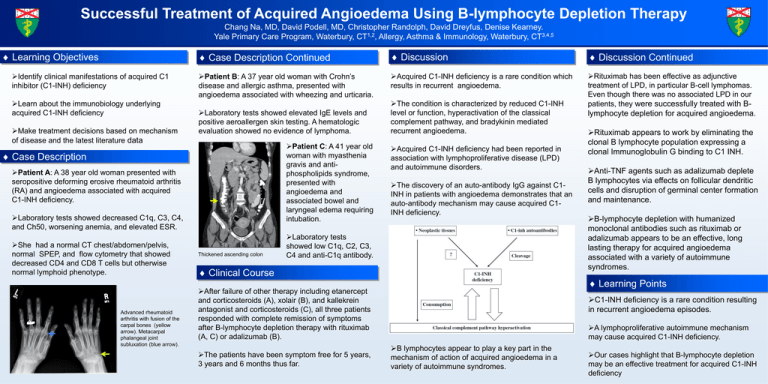
Successful Treatment of Acquired Angioedema Using B-lymphocyte Depletion Therapy Chang Na, MD, David Podell, MD, Christopher Randolph, David Dreyfus, Denise Kearney. Yale Primary Care Program, Waterbury, CT1,2, Allergy, Asthma & Immunology, Waterbury, CT3,4,5 Learning Objectives Identify clinical manifestations of acquired C1 inhibitor (C1-INH) deficiency Learn about the immunobiology underlying acquired C1-INH deficiency Make treatment decisions based on mechanism of disease and the latest literature data Case Description Continued Discussion Discussion Continued Patient B: A 37 year old woman with Crohn’s disease and allergic asthma, presented with angioedema associated with wheezing and urticaria. Acquired C1-INH deficiency is a rare condition which results in recurrent angioedema. Rituximab has been effective as adjunctive treatment of LPD, in particular B-cell lymphomas. Even though there was no associated LPD in our patients, they were successfully treated with B- Laboratory tests showed elevated IgE levels and positive aeroallergen skin testing. A hematologic evaluation showed no evidence of lymphoma. Patient C: A 41 year old woman with myasthenia gravis and antiphospholipids syndrome, presented with angioedema and associated bowel and laryngeal edema requiring intubation. Case Description Patient A: A 38 year old woman presented with seropositive deforming erosive rheumatoid arthritis (RA) and angioedema associated with acquired C1-INH deficiency. Laboratory tests showed decreased C1q, C3, C4, and Ch50, worsening anemia, and elevated ESR. She had a normal CT chest/abdomen/pelvis, normal SPEP, and flow cytometry that showed decreased CD4 and CD8 T cells but otherwise normal lymphoid phenotype. Advanced rheumatoid arthritis with fusion of the carpal bones (yellow arrow). Metacarpal phalangeal joint subluxation (blue arrow). Thickened ascending colon The condition is characterized by reduced C1-INH level or function, hyperactivation of the classical complement pathway, and bradykinin mediated recurrent angioedema. Acquired C1-INH deficiency had been reported in association with lymphoproliferative disease (LPD) and autoimmune disorders. The discovery of an auto-antibody IgG against C1INH in patients with angioedema demonstrates that an auto-antibody mechanism may cause acquired C1INH deficiency. Laboratory tests showed low C1q, C2, C3, C4 and anti-C1q antibody. Clinical Course Rituximab appears to work by eliminating the clonal B lymphocyte population expressing a clonal Immunoglobulin G binding to C1 INH. Anti-TNF agents such as adalizumab deplete B lymphocytes via effects on follicular dendritic cells and disruption of germinal center formation and maintenance. B-lymphocyte depletion with humanized monoclonal antibodies such as rituximab or adalizumab appears to be an effective, long lasting therapy for acquired angioedema associated with a variety of autoimmune syndromes. Learning Points After failure of other therapy including etanercept and corticosteroids (A), xolair (B), and kallekrein antagonist and corticosteroids (C), all three patients responded with complete remission of symptoms after B-lymphocyte depletion therapy with rituximab (A, C) or adalizumab (B). The patients have been symptom free for 5 years, 3 years and 6 months thus far. lymphocyte depletion for acquired angioedema. C1-INH deficiency is a rare condition resulting in recurrent angioedema episodes. A lymphoproliferative autoimmune mechanism may cause acquired C1-INH deficiency. B lymphocytes appear to play a key part in the mechanism of action of acquired angioedema in a variety of autoimmune syndromes. Our cases highlight that B-lymphocyte depletion may be an effective treatment for acquired C1-INH deficiency

